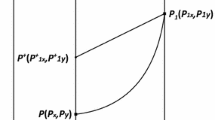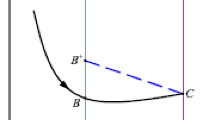Abstract
In this paper, a new model with two state impulses is proposed for pest management. According to different thresholds, an integrated strategy of pest management is considered, that is to say if the density of the pest population reaches the lower threshold \(h_1\) at which pests cause slight damage to the forest, biological control (releasing natural enemy) will be taken to control pests; while if the density of the pest population reaches the higher threshold \(h_2\) at which pests cause serious damage to the forest, both chemical control (spraying pesticide) and biological control (releasing natural enemy) will be taken at the same time. For the model, firstly, we qualitatively analyse its singularity. Then, we investigate the existence of periodic solution by successor functions and Poincaré-Bendixson theorem and the stability of periodic solution by the stability theorem for periodic solutions of impulsive differential equations. Lastly, we use numerical simulations to illustrate our theoretical results.





























Similar content being viewed by others
References
Bainov, D., Simeonov, P.S.: Systems with impulse effect: stability, theory, and applications. Ellis Horwood, Chichester (1989)
Bainov, D.D., Hristova, S.G., Hu, S., et al.: Periodic boundary value problems for systems of first order impulsive differential equations. Differ. Integral Equ. 2, 37–43 (1989)
Bainov, D., Simeonov, P.S.: Impulsive differential equations: periodic solutions and applications. Longman, Harlow (1993)
Bale, J.S., Van Lenteren, J.C., Bigler, F.: Biological control and sustainable food production. Philos. Trans. R. Soc. B 363(1492), 761–776 (2008)
Bonotto, E.M., Federson, M.: Topological conjugation and asymptotic stability in impulsive semidynamical systems. J. Math. Anal. Appl. 326(2), 869–881 (2007)
Bonotto, E.M., Federson, M.: Limit sets and the Poincaré–Bendixson theorem in impulsive semidynamical systems. J. Differ. Equ. 244(9), 2334–2349 (2008)
Bonotto, E.M.: LaSalle‘s theorems in impulsive semidynamical systems. Nonlinear Anal. 71(5), 2291–2297 (2009)
Erbe, L.H., Liu, X.: Existence of periodic solutions of impulsive differential systems. Int. J. Stoch. Anal. 4(2), 137–146 (1991)
Frigon, M., O’Regan, D.: Existence results for first-order impulsive differential equations. J. Math. Anal. Appl. 193(1), 96–113 (1995)
Canadian Forest Service. http://cfs.nrcan.gc.ca/home
Dai, C., Zhao, M., Chen, L.: Homoclinic bifurcation in semi-continuous dynamic systems. Int. J. Biomath. 5(06), 1250059 (2012)
Focus On Forest Health, Alberta Environment and Alberta Sustainable Resource Development (2003)
Gompertz, B.: On the nature of the function expressive of the law of human mortality, and on a new mode of determining the value of life contingencies. Philos. Trans. R. Soc. Lond. 115, 513–583 (1825)
Huang, M., Liu, S., Song, X., et al.: Periodic solutions and homoclinic bifurcation of a predator-Cprey system with two types of harvesting. Nonlinear Dyn. 64, 1–12 (2013)
Hui, J., Zhu, D.: Dynamic complexities for prey-dependent consumption integrated pest management models with impulsive effects. Chaos Solitons Fractals 29(1), 233–251 (2006)
Jiao, J., Chen, L., Cai, S.: Impulsive control strategy of a pest management SI model with nonlinear incidence rate. Appl. Math. Model. 33(1), 555–563 (2009)
Lakshmikantham, V., Bainov, D.D., Simeonov, P.S.: Theory of impulsive differential equations. World Scientific Publishing Company, Singapore (1989)
Li, Z., Chen, L.: Periodic solution of a turbidostat model with impulsive state feedback control. Nonlinear Dyn. 58(3), 525–538 (2009)
Li, Z., Chen, L., Huang, J.: Permanence and periodicity of a delayed ratio-dependent predator-prey model with Holling type functional response and stage structure. J. Comput. Appl. Math. 233(2), 173–187 (2009)
Liu, B., Zhang, Y., Chen, L.: Dynamic complexities of a Holling I predator Cprey model concerning periodic biological and chemical control. Chaos Solitons Fractals 22(1), 123–134 (2004)
Liu, B., Zhang, Y., Chen, L.: The dynamical behaviors of a Lotka-Volterra predator-prey model concerning integrated pest management. Nonlinear Anal. 6(2), 227–243 (2005)
Liu, B., Chen, L., Zhang, Y.: The dynamics of a prey-dependent consumption model concerning impulsive control strategy. Appl. Math. Comput. 169(1), 305–320 (2005)
Mailleret, L., Grognard, F.: Global stability and optimisation of a general impulsive biological control model. Math. Biosci. 221(2), 91–100 (2009)
Meng, X., Jiao, J., Chen, L.: The dynamics of an age structured predator-prey model with disturbing pulse and time delays. Nonlinear Anal. 9(2), 547–561 (2008)
Meng, X., Chen, L.: Permanence and global stability in an impulsive Lotka-Volterra N-species competitive system with both discrete delays and continuous delays. Int. J. Biomath. 1(02), 179–196 (2008)
Nieto, J.J.: Basic theory for nonresonance impulsive periodic problems of first order. J. Math. Anal. Appl. 205(2), 423–433 (1997)
Nieto, J.J., O’Regan, D.: Variational approach to impulsive differential equations. Nonlinear Anal. 10(2), 680–690 (2009)
Nie, L., Teng, Z., Hu, L., et al.: Existence and stability of periodic solution of a predator-prey model with state-dependent impulsive effects. Math. Comput. Simul. 79(7), 2122–2134 (2009)
Nie, L., Peng, J., Teng, Z., et al.: Existence and stability of periodic solution of a Lotka-Volterra predator-prey model with state dependent impulsive effects. J. Comput. Appl. Math. 224(2), 544–555 (2009)
Nie, L., Teng, Z., Hu, L., et al.: Qualitative analysis of a modified Leslie-Gower and Holling-type II predator-prey model with state dependent impulsive effects. Nonlinear Anal. 11(3), 1364–1373 (2010)
Science Features: Forest Pests: Boring a Hole in Your Wallet, www.nature.org/ourscience/sciencefeatures/
Shi, R., Jiang, X., Chen, L.: A predator-prey model with disease in the prey and two impulses for integrated pest management. Appl. Math. Model. 33(5), 2248–2256 (2009)
Shi, R., Chen, L.: The study of a ratio-dependent predator-prey model with stage structure in the prey. Nonlinear Dyn. 58(1–2), 443–451 (2009)
Song, X., Hao, M., Meng, X.: A stage-structured predator-prey model with disturbing pulse and time delays. Appl. Math. Model. 33(1), 211–223 (2009)
Sun, S., Chen, L.: Mathematical modelling to control a pest population by infected pests. Appl. Math. Model. 33(6), 2864–2873 (2009)
Tang, S., Cheke, R.A.: State-dependent impulsive models of integrated pest management (IPM) strategies and their dynamic consequences. J. Math. Biol. 50(3), 257–292 (2005)
Trzcinski, M.K., Reid, M.L.: Intrinsic and extrinsic determinants of mountain pine beetle population growth. Agric. For. Entomol. 11(2), 185–196 (2009)
Zeng, G., Chen, L., Sun, L.: Existence of periodic solution of order one of planar impulsive autonomous system. J. Comput. Appl. Math. 186(2), 466–481 (2006)
Zhang, T., Meng, X., Song, Y.: The dynamics of a high-dimensional delayed pest management model with impulsive pesticide input and harvesting prey at different fixed moments. Nonlinear Dyn. 64(1), 1–12 (2011)
Zhang, T., Meng, X., Song, Y., et al.: Dynamical analysis of delayed plant disease models with continuous or impulsive cultural control strategies. Abstract and applied analysis. Hindawi Publishing Corporation, New York (2012)
Zhang, H., Chen, L., Nieto, J.J.: A delayed epidemic model with stage-structure and pulses for pest management strategy. Nonlinear Anal. 9(4), 1714–1726 (2008)
Zhang, H., Georgescu, P., Chen, L.: An impulsive predator-prey system with Beddington–Deangelis functional response and time delay. Int. J. Biomath. 1(01), 1–17 (2008)
Zhao, L., Chen, L., Zhang, Q.: The geometrical analysis of a Predator-prey model with two state impulses. Math. Biosci. 238, 55–64 (2012)
Zhao, W., Zhang, T., Meng, X., Yang, Y.: Dynamical analysis of a pest management model with saturated growth rate and state dependent impulsive effects. Abstract and applied analysis. Hindawi Publishing Corporation, New York (2013)
Acknowledgments
We would like to thank the anonymous referees for their valuable comments and suggestions. The research has been supported by National Natural Science Foundation of China (Grant No. 11371230), Natural Sciences Fund of Shandong Province (Grant No. ZR2012AM012) and A Project for Higher Educational Science and Technology Program of Shandong Province (Grant No. J13LI05).
Author information
Authors and Affiliations
Corresponding author
Rights and permissions
About this article
Cite this article
Zhang, T., Meng, X., Liu, R. et al. Periodic solution of a pest management Gompertz model with impulsive state feedback control. Nonlinear Dyn 78, 921–938 (2014). https://doi.org/10.1007/s11071-014-1486-y
Received:
Accepted:
Published:
Issue Date:
DOI: https://doi.org/10.1007/s11071-014-1486-y




